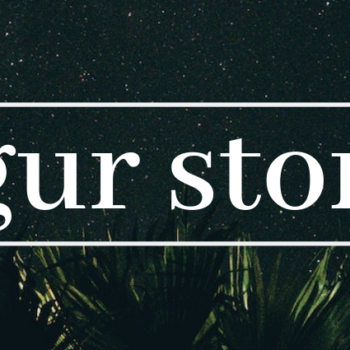All Too Casual: Taking Responsibility in Artistic Representations
- Posted by Augur Blog
- On January 15, 2019
- 0 Comments
- cover art, speculative art
By Lorna Antoniazzi
It’s the beginning of a new year—a time to look to look forward to all the new plans, but also a good time to look back at everything we’ve already accomplished. Today we’ve dug up one of Kickstarter essays that introduced Augur to all of you.
Our cover artist, Lorna Antoniazzi, has written about the responsibility an artist has to ensure that intersectionality is included in renderings of stories.
I feel it’s important to recognize this right off the bat: I am lucky because I have never struggled to find fictional characters that look the way I do.
From a young age, I have consumed art and television that reflect versions of my features back at me. I take strongly after my mother’s side, all blonde hair and blue eyes and English. But for undisclosed reasons I will permit myself to tell you that this does not always mean I have seen myself in fictional characters.
Sci-fi and fantasy—inconsequential of being “make-believe”—are haunted by racial, sexist, stereotypical
It’s hidden in the pages of a five-book, medieval fantasy saga, which has possibly one person of colour in the entire collection. It’s bringing up the rear end of a sci-fi space opera, where English is the only language to survive on the tongues and minds of all that remains of the human race. It’s nestled at the heart of a dystopia that denounces classism, but in the very same breath denounces women.
And it’s biting at the ankles of artwork, just the same.
Art has a very particular, very important distinction from literary texts; unlike words on a page, there’s far less room to be vague or hidden when you’re smack-dab in the middle of an illustration. Everything is, to go with the cliché, right there on the page.
In a way, this inhibits the imagination of the viewer, because there’s less flexibility when it comes to imprinting yourself onto a character that has to be visually described. An example: what does Harry Potter look like? The first image that probably comes to mind is of Daniel Radcliffe—this is the artwork side of things, where you the audience have been given a set image of the protagonist to empathize with. But the book never fully describes what Harry looks like.
Black hair. Green eyes. Knobby knees. Scar, glasses.
It helps that Harry Potter is a big enough franchise that Harry’s ethnicity actually has been tendentiously debated. It helps even more that some lovely people on the Internet have compiled every instance that J.K. Rowling describes Harry’s physical appearance. So we can have these arguments—nothing is set in stone! Death of the author! Who says James Potter couldn’t be Indian (one of the more popular interpretations)? Who says Harry can’t be Indian?
Now, maybe you didn’t think of Daniel Radcliffe, when you played along and visualized Harry Potter. Maybe you thought of one of the many book covers, distributed across many nations, in which Harry is almost definitely Caucasian.
And see? Now we are back at stage one.
So perhaps the burden of representation falls just as equally on artists as it does on authors. And, extending this, it might mean that there’s a responsibility for artists to not only envision worlds that are fantastical, but to populate them with visible intersectionality. Because in illustration we can see who is missing, possibly in a more visceral way than in writing.
This won’t be the first or last block of writing (not even the first in these Augur updates) to tell you that it’s disquietingly easy for people who don’t fit in to empathize with monsters. Creatures, critters, aliens, and the entire back of comics hinges upon the idea that those who do not see themselves on paper can find themselves in things that look like nobody else.
On one hand, this helps us rewrite the narrative of monsters—much like one of my favourite quotes, Janice Lee’s “Draw a monster. Why is it a monster?”—but it also foists the supernatural creatures we see in sci-fi, fantasy, and horror into
The answer could be anything. Ethnicity, gender, sexuality, physical and/or mental disability. As anyone who has ever seen some part of them played off as a joke in fiction can tell you, something that others might deign to acknowledge could be the very first thing you search for. And in art, it becomes increasingly simpler to search.
To this end, it might be time to recognize that pages and prose can be intersectional, and have the space to be. Particularly in mediums where we can see who was—and was not—invited to the table.
And honestly, even if we couldn’t, why not populate your art to reflect difference? Excuses have been spread far and wide, but they grow thinner by the day (and often by the dragon). This is especially true for fantastical fiction, which can so easily manipulate physics but often bucks violently at the mere prospect of a disabled lead or same-sex relationship. Our work needs to become more capacious, critical, and open to discussion and growth.
Even artists who create work based on pre-made content need to be aware of what they’re portraying; an illustration of a too-slim girl can do a lot of damage against the efforts of an author trying write a character who embraces body positivity. At what point do fans have to disentangle the written word from its accompanying art, as part of an on-going project to reject alienation? And what would happen if they never had to—if artists were given the time, education, and room to reject wrongful representation? What would our stories look like then?
Perhaps this is where spaces like Augur step in.
From the beginning, Augur set out on a mission to end the need for people who pick through the pillars of their youth with a fine-toothed comb, searching for vagueness or implications that their favourite characters might resemble them a little bit more. The notion rests directly at odds with what Augur is going for.
We want to hear you, read you, and see you.
More than anything else, my hope for Augur is that it encourages authors (and illustrators!) to bring themselves and their stories in tandem. Ferociously embody that which has been neglected. Unabashed, and with the ability to see that you might be exactly what we’ve been waiting for.
Enjoyed the read? We think you might also like this one: Graphic Fiction and Cultural Inheritance.




0 Comments